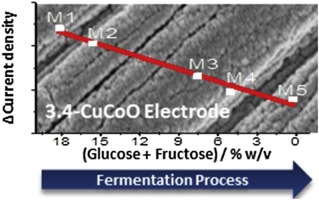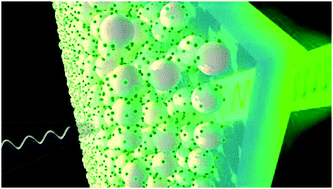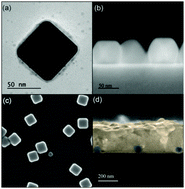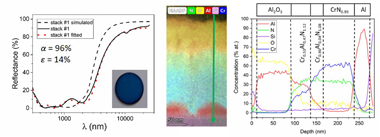Artículos SCI
2020
2020
Nanotecnología en Superficies y Plasma
Robust label-free CuxCoyOz electrochemical sensors for hexose detection during fermentation process monitoring
Lopez-Fernandez, E; Gil-Rostra, J; Espinos, JP; Gonzalez, R; Yubero, F; de Lucas-Consuegra, A; Gonzalez-Elipe, ARSensors and Actuators B-Chemical, 304 (2020) 127360
Show abstract ▽

Label free electrochemical sensors of glucose are used whenever long-term operation and stable response are required. For this purpose, various metals and oxides of the first transition series have been proposed as alternative to more expensive noble metal electrochemical sensors. In this work we propose a new formulation consisting of copper-cobalt mixed oxides which, in the form of porous and nanostructured thin films with well controlled Co/Cu ratio, are prepared at room temperature in one step by a modification of the magnetron sputtering oblique angle deposition procedure. Films with various compositions were electrochemically characterized by cyclic voltammetry to determine their amperometric response to glucose as a function of voltage and NaOH electrolyte concentration. This analysis showed that films with a Co/Cu atomic ratio equal 3.4 presented a maximum sensitivity (0.710 A M−1 cm−2), a small limit of detection (0.105 μM) and a resilient behaviour upon cycling operation and long storage periods that clearly overpassed the performance of copper and cobalt single oxides. The CuxCoyO electrocatalysts also presented a good selectivity towards glucose and fructose in the presence of common interference compounds found in biological fluids (e.g., ascorbic acid, acetaminophen and uric acid), sucrose and ethanol, this latter present in many agrofood liquids. The possibilities of this sensor electrocatalyst have been tested for the analysis of a wine synthetic fermentation process. The comparison of the electrochemical results with conventional analytical methods showed a lineal amperometric response with respect hexose contents in a must at different stages of its transformation into wine.
Febrero, 2020 | DOI: 10.1016/j.snb.2019.127360
Materiales Ópticos Multifuncionales
Efficient third harmonic generation from FAPbBr(3) perovskite nanocrystals
Rubino, A; Huq, T; Dranczewski, J; Lozano, G; Calvo, ME; Vezzoli, S; Miguez, H; Sapienza, RJournal of Materials Chemistry C, 8 (2020) 15990-15995
Show abstract ▽

The development of versatile nanostructured materials with enhanced nonlinear optical properties is relevant for integrated and energy efficient photonics. In this work, we report third harmonic generation from organic lead halide perovskite nanocrystals, and more specifically from formamidinium lead bromide nanocrystals, ncFAPbBr(3), dispersed in an optically transparent silica film. Efficient third order conversion is attained for excitation in a wide spectral range in the near infrared (1425 nm to 1650 nm). The maximum absolute value of the modulus of the third order nonlinear susceptibility of ncFAPbBr(3), chi((3)NC), is derived from modelling both the linear and nonlinear behaviour of the film and is found to be chi((3)NC) = 1.46 x 10(-19) m(2) V-2 (or 1.04 x 10(-11) esu) at 1560 nm excitation wavelength, which is of the same order as the highest previously reported for purely inorganic lead halide perovskite nanocrystals (3.78 x 10(-11) esu for ncCsPbBr(3)). Comparison with the experimentally determined optical constants demonstrates that maximum nonlinear conversion is attained at the excitonic resonance of the perovskite nanocrystals where the electron density of states is largest. The ease of synthesis, the robustness and the stability provided by the matrix make this material platform attractive for integrated nonlinear devices.
Diciembre, 2020 | DOI: 10.1039/d0tc04790b
Materiales Ópticos Multifuncionales
Localized surface plasmon effects on the photophysics of perovskite thin films embedding metal nanoparticles
Bayles, A; Carretero-Palacios, S; Calio, L; Lozano, G; Calvo, ME; Miguez, HJournal of Materials Chemistry C, 8 (2020) 916-921
Show abstract ▽

Herein we provide direct experimental evidence that proves that the photophysical properties of thin methylammonium lead iodide perovskite films are significantly enhanced by localized surface plasmon resonances (SPRs). Observations are well supported by rigorous calculations that prove that improved light harvesting can be unequivocally attributed to plasmonic scattering and near field reinforcement effects around silver nanoparticles embedded within the semiconductor layer. Adequate design of the localized SPR allows raising the absorptance of a 300 nm thick film at well-defined spectral regions while minimizing the parasitic absorption from the metallic inclusions. Measured enhancements can be as large as 80% at specific wavelengths and 20% when integrated over the whole range at which SPR occurs, in agreement with theoretical estimations. Simultaneously, the characteristic quenching effect that the vicinity of metals has on the photoluminescence of semiconductors is largely compensated for by the combined effect of the enhanced photoexcitation and the higher local density of photon states occurring at SPR frequencies, with a two fold increase of the perovskite photoemission efficiency being measured.
Marzo, 2020 | DOI: 10.1039/c9tc05785d
Tribología y Protección de Superficies
High-temperature solar-selective coatings based on Cr(Al)N. Part 2: Design, spectral properties and thermal stability of multilayer stacks
Rojas, TC; Caro, A; Escobar-Galindo, R; Sanchez-Lopez, JCSolar Energy Materials and Solar Cells, 218 (2020) 110812
Show abstract ▽

Two multilayer solar selective absorber coatings [Al/CrN0.95/Cr0.96Al0.04N1.08/Cr0.53Al0.47N1.12/Al2O3 (stack #1) and Cr0.96Al0.04N0.89/Cr0.62Al0.38N1.00/Cr0.53Al0.47N1.12/Al2O3 (stack #2)] were deposited on 316L steel by combining direct current (DC) and high power impulse magnetron sputtering (HiPIMS) technologies with the aim of increasing the working limit temperature. The composition and thickness of the constituent layers were optimized using CODE software to achieve a high solar absorptance (alpha) and low values of thermal emittance (epsilon) in the infrared region. The deposited multilayered stacks were heated during 2 h in air at 600, 700 and 800 degrees C to study their thermal stability and optical performance. Compositional, structural and optical characterization of the stacks (as-prepared and after thermal treatment) was performed. Both stacks presented a good solar selectivity with alpha > 95% and epsilon < 15%, were stable up to 600 degrees C and fulfilled the performance criterion PC < 5% after 600 and 700 degrees C treatments. Despite the stacks suffered chemical transformations above 600 degrees C, partial oxidation (stack #1) and Cr2N formation (stack #1 and #2), the optical properties were optimum up to 700 degrees C for stack #1 (alpha = 94%, epsilon((25 degrees C)) = 12%) and 600 degrees C for stack #2 (alpha = 93%, epsilon((25 degrees C)) = 13%). The solar-to-mechanical energy conversion efficiencies (eta) of the as-deposited and annealed (600 and 700 degrees C) samples were up to 20% points higher than the absorber paint commercially used (Pyromark). At 800 degrees C, they underwent a further structural transformation, provoked by the oxidation of the inner layers, and they consequently lost their solar selectivity.
Diciembre, 2020 | DOI: 10.1016/j.solmat.2020.110812
Materiales de Diseño para la Energía y Medioambiente
New biomorphic filters to face upcoming particulate emissions policies: A review of the FIL-BIO-DIESEL project
Orihuela, MP; Chacartegui, R; Martinez-Fernandez, JEnergy, 201 (2020) 117577
Show abstract ▽
With a high number of diesel vehicles worldwide, particulate emission control is an urgent issue with a global impact, from the health of citizens to commercial future of this technology in some transport segments. Particulate filters are widely used in automotive engines to comply emissions regulations, but current technologies have room for improvement as they add additional backpressure in the exhaust system, and efficient on-board regeneration process is challenging.
The Fil-Bio-Diesel Project is a R&D initiative to improve current particle filtration systems, based on the development of novel biomorphic substrates. By replicating the biologic tissue of a wood precursor, a biomorphic silicon carbide with hierarchic orthotropic microstructure can be produced. The porosity, the pore size, and pore orientation of this bioceramic material can be tailored through the selection of a suitable precursor, widening the initially narrow relationship between filtration efficiency and pressure drop that characterizes granular ceramic materials. In this paper the methodology and main results of the Fil-Bio-Diesel Project are presented. This work shows the peculiar advantages of biomorphic silicon carbide through several experimental studies. The results show the potential of this novel filter substrate to be used in future particulate abatement systems.
Junio, 2020 | DOI: 10.1016/j.energy.2020.117577
- ‹ anterior
- 95 of 412
- siguiente ›
icms











